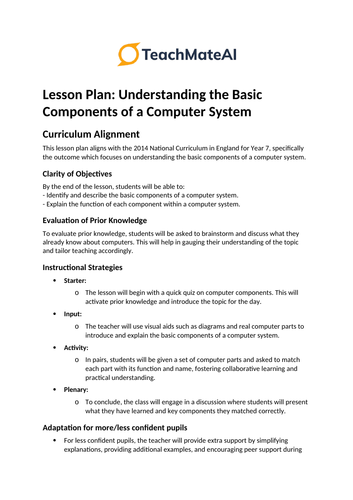
Introduction to Computing:
Understanding the basic components of a computer system.
Introduction to computing involves understanding the fundamental components that make up a computer system. Here are the key components:
Central Processing Unit (CPU):
Often referred to as the brain of the computer, the CPU carries out instructions of a computer program. It performs calculations, manages data, and controls other hardware components.
Memory (RAM - Random Access Memory):
RAM is a type of volatile memory that provides temporary storage for data and program instructions. It allows quick access to information that the CPU is currently using or processing.
Storage Devices:
Hard Disk Drives (HDD) and Solid State Drives (SSD) are common storage devices. They store data and programs persistently, even when the computer is turned off. HDDs use spinning disks, while SSDs use flash memory for faster data access.
Motherboard:
The motherboard is the main circuit board that connects and allows communication between various hardware components. It houses the CPU, memory, and other essential connectors and chips.
Input Devices:
Devices that allow users to input data into the computer. Common examples include keyboards, mice, touchpads, and more specialized input devices like scanners and cameras.
Output Devices:
Devices that present information to the user. Examples include monitors (for visual output), printers (for hard copy output), and speakers (for audio output).
Peripheral Devices:
Additional devices connected to the computer to expand its functionality. This includes external hard drives, USB drives, printers, and other accessories.
Power Supply:
Converts electrical power from an outlet into a form usable by the computer. It provides power to the various components of the computer.
Operating System:
Software that manages computer hardware and provides services for computer programs. Common operating systems include Windows, macOS, and Linux.
Software:
Programs and applications that run on the computer. This includes the operating system, productivity software, games, and other applications.
Understanding the interplay between these components is crucial for grasping how computers function. It lays the foundation for more advanced topics such as programming, networking, and system administration. As students delve into computing, they often explore how these components work together to execute tasks and process information.
Something went wrong, please try again later.
This resource hasn't been reviewed yet
To ensure quality for our reviews, only customers who have purchased this resource can review it
Report this resourceto let us know if it violates our terms and conditions.
Our customer service team will review your report and will be in touch.
